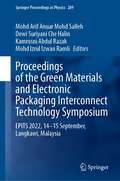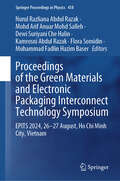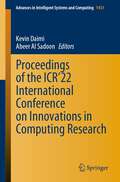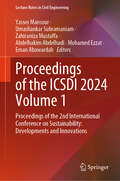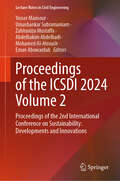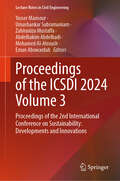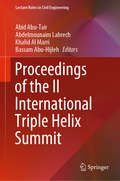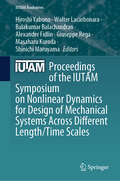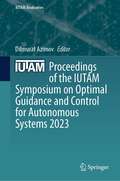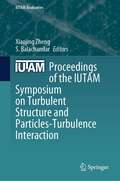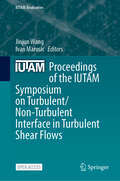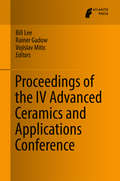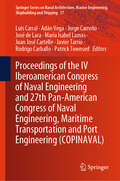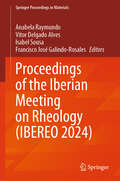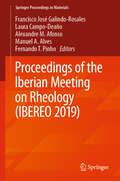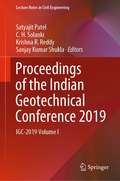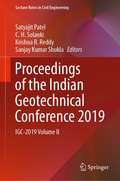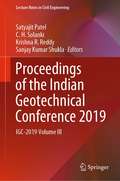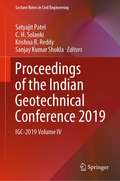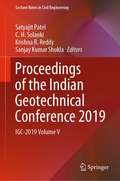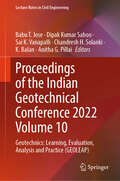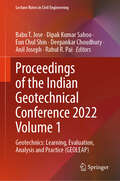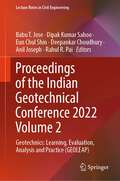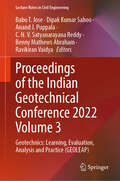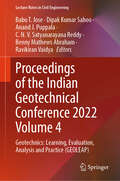- Table View
- List View
Proceedings of the Green Materials and Electronic Packaging Interconnect Technology Symposium: EPITS 2022, 14-15 September, Langkawi, Malaysia (Springer Proceedings in Physics #289)
by Mohd Arif Anuar Mohd Salleh Mohd Izrul Izwan Ramli Dewi Suriyani Che Halin Kamrosni Abdul RazakThis book presents peer reviewed articles from the Green Materials and Electronic Packaging Interconnect Technology Symposium, (EPITS 2022), held in Langkawi, Malaysia on 14th and 15th of Sept, 2022. It brings together packaging experts to share and exchange ideas in electronics technology. Topics covered in this volume include, but are not limited to; (1) Green materials and technology, (2) Emerging interconnect materials and technologies,(3) Non-solder interconnect materials at chip and package levels, (4) Fundamental materials behavior for electronic packaging materials, (5) Advanced characterization methods as applied to electronic packaging technology, (6) Developments in high temperature Pb-free solders and associated interconnects for automotive and power electronics, (7) Surface coating materials & (8) Advanced materials.
Proceedings of the Green Materials and Electronic Packaging Interconnect Technology Symposium: EPITS 2024, 26-27 August, Ho Chi Minh City, Vietnam (Springer Proceedings in Physics #418)
by Mohd Arif Anuar Mohd Salleh Dewi Suriyani Che Halin Kamrosni Abdul Razak Nurul Razliana Abdul Razak Flora Somidin Muhammad Fadlin Hazim BaserThis book highlights a comprehensive exposition of recent advancements and research in green materials and electronic packaging interconnect technology. It features peer reviewed articles from the Electronic Packaging Interconnect Technology Symposium (EPITS) 2024, and delves into pivotal areas of electronics packaging, ranging from micro to nano-scale domains. Topics explored include advancements in green materials and technology, interconnect solutions at both chip and package levels, surface coatings, and broader innovations in electronic packaging materials. EPITS provides a platform for the global exchange of innovative concepts and the advancement of cutting-edge research in electronic packaging by uniting multi-disciplinary specialists from academia, business, and government. This initiative directs focus towards recent remarkable breakthroughs in electronic materials and anticipates future trends and requirements in the field. This proceedings provides readers with an understanding of the potential and problems associated with electronic packaging and green materials, which is advancing the development of more environmentally friendly and effective electronic systems.
Proceedings of the ICR’22 International Conference on Innovations in Computing Research (Advances in Intelligent Systems and Computing #1431)
by Kevin Daimi Abeer Al SadoonThis book, Proceedings of the ICR´22 International Conference on Innovations in Computing Research, provides an essential compilation of relevant and cutting-edge academic and industry work on key computer and network security, smart cities, smart energy, IoT, health informatics, biomedical imaging, data science and computer science and engineering education topics. It offers an excellent professional development resource for educators and practitioners on the state-of-the-art in these areas and contributes towards the enhancement of the community outreach and engagement component of the above-mentioned areas. Various techniques, methods, and approaches adopted by experts in these fields are introduced. This book provides detailed explanation of the concepts that are pertinently reinforced by practical examples, and a road map of future trends that are suitable for innovative computing research. It is written by professors, researchers, and industry professionals with long experience in these fields to furnish a rich collection of manuscripts in highly regarded topics that have not been creatively compiled together before. This book can be a valuable resource to university faculty, students to enhance their research work and as a supplement to their courses in these fields, researchers, and industry professionals. Furthermore, it is a valuable tool to experts in these areas to contribute towards their professional development efforts.
Proceedings of the ICSDI 2024 Volume 1: Proceedings of the 2nd International Conference on Sustainability: Developments and Innovations (Lecture Notes in Civil Engineering #556)
by Umashankar Subramaniam Yasser Mansour Zahiraniza Mustaffa Abdelhakim Abdelhadi Eman Abowardah Mohamed EzzatThis book offers a comprehensive overview of the latest research, innovations, and practical applications in the field of sustainability, with a focus on construction materials and their use in building and civil engineering structures. As an outcome of the 2nd International Conference on Sustainability: Developments and Innovations (ICSDI 2024), the book presents a selection of peer-reviewed papers from prominent researchers and engineers around the world. The book covers a broad range of topics, including construction and resilient infrastructure, sustainable manufacturing, industrial ecology, renewable energy, future cities, sustainable built environment design, and policies, regulations, and economics for achieving sustainable development goals. This book will serve as an essential reference for graduate students, engineers, and scientists, as well as industry professionals working in the field of sustainability. The book aligns with the scope of book series scope which aims tocontribute to progress in the construction sciences, techniques, and industries through communication between research and practice. It is also a valuable resource for practitioners and policymakers who are interested in understanding the latest technological advancements and innovations in sustainability to solve real-world problems.
Proceedings of the ICSDI 2024 Volume 2: Proceedings of the 2nd International Conference on Sustainability: Developments and Innovations (Lecture Notes in Civil Engineering #557)
by Umashankar Subramaniam Yasser Mansour Zahiraniza Mustaffa Abdelhakim Abdelhadi Mohamed Al-Atroush Eman AbowardahThis book offers a comprehensive overview of the latest research, innovations, and practical applications in the field of sustainability, with a focus on construction materials and their use in building and civil engineering structures. As an outcome of the 2nd International Conference on Sustainability: Developments and Innovations (ICSDI 2024), the book presents a selection of peer-reviewed papers from prominent researchers and engineers around the world. The book covers a broad range of topics, including construction and resilient infrastructure, sustainable manufacturing, industrial ecology, renewable energy, future cities, sustainable built environment design, and policies, regulations, and economics for achieving sustainable development goals. This book will serve as an essential reference for graduate students, engineers, and scientists, as well as industry professionals working in the field of sustainability. The book aligns with the scope of book series scope which aims tocontribute to progress in the construction sciences, techniques, and industries through communication between research and practice. It is also a valuable resource for practitioners and policymakers who are interested in understanding the latest technological advancements and innovations in sustainability to solve real-world problems.
Proceedings of the ICSDI 2024 Volume 3: Proceedings of the 2nd International Conference on Sustainability: Developments and Innovations (Lecture Notes in Civil Engineering #558)
by Umashankar Subramaniam Yasser Mansour Zahiraniza Mustaffa Abdelhakim Abdelhadi Mohamed Al-Atroush Eman AbowardahThis book offers a comprehensive overview of the latest research, innovations, and practical applications in the field of sustainability, with a focus on construction materials and their use in building and civil engineering structures. As an outcome of the 2nd International Conference on Sustainability: Developments and Innovations (ICSDI 2024), the book presents a selection of peer-reviewed papers from prominent researchers and engineers around the world. The book covers a broad range of topics, including construction and resilient infrastructure, sustainable manufacturing, industrial ecology, renewable energy, future cities, sustainable built environment design, and policies, regulations, and economics for achieving sustainable development goals. This book will serve as an essential reference for graduate students, engineers, and scientists, as well as industry professionals working in the field of sustainability. The book aligns with the scope of book series scope which aims tocontribute to progress in the construction sciences, techniques, and industries through communication between research and practice. It is also a valuable resource for practitioners and policymakers who are interested in understanding the latest technological advancements and innovations in sustainability to solve real-world problems.
Proceedings of the II International Triple Helix Summit (Lecture Notes in Civil Engineering #43)
by Abid Abu-Tair Abdelmounaim Lahrech Khalid Al Marri Bassam Abu-HijlehThis volume gathers the latest advances and innovations in the triple helix of university-industry-government relations, as presented by leading international researchers at the II International Triple Helix Summit 2018, held in Dubai, UAE on November 10-13, 2018, which brought together experts, practitioners and academics across disciplines that address the dynamics of government, industry and academia. It covers analysis, theory, measurements and empirical enquiry in all aspects of university-industry-government interactions, as well as the international bases and dimensions of triple helix relations, their impacts, and social, economic, political, cultural, health and environmental implications. It also examines the role of government/academia/industry in building innovation-based cities and nations, and in transforming nations into knowledge-based sustainable economies. The contributions, which were selected by means of a rigorous international peer-review process, highlight numerous exciting ideas that will spur novel research directions and foster multidisciplinary collaboration among different specialists.
Proceedings of the IUTAM Symposium on Nonlinear Dynamics for Design of Mechanical Systems Across Different Length/Time Scales (IUTAM Bookseries #43)
by Walter Lacarbonara Giuseppe Rega Alexander Fidlin Balakumar Balachandran Hiroshi Yabuno Masaharu Kuroda Shinichi MaruyamaThis book presents insights from the IUTAM Symposium on Nonlinear Dynamics for Design of Mechanical Systems Across Different Length/Time Scales. It covers a diverse array of topics, including applications of parametric amplification and self-excitation, as well as the design and analysis of devices and systems that harness geometric and material nonlinearities. The book features chapters on nonlinear energy transfer, eigenfrequency detection through subharmonic and superharmonic resonances, and the innovative use of nonlinear mode localization. The authors explore dynamic stabilization under high-frequency excitation, the utilization of multimode interactions and nonlinear normal modes, and the application of nonlinear resonance and bifurcation in creating ultrasensitive sensors and high-performance actuators. This book provides a comprehensive record of the symposium's discussions, representing a collective effort to expand our understanding of nonlinear phenomena and its potential to reshape the landscape of mechanical system design.
Proceedings of the IUTAM Symposium on Optimal Guidance and Control for Autonomous Systems 2023 (IUTAM Bookseries #40)
by Dilmurat AzimovThis book showcases a collection of papers that present cutting-edge studies, methods, experiments, and applications in various interdisciplinary fields. These fields encompass optimal control, guidance, navigation, game theory, stability, nonlinear dynamics, robotics, sensor fusion, machine learning, and autonomy. The chapters reveal novel studies and methods, providing fresh insights into the field of optimal guidance and control for autonomous systems. The book also covers a wide range of relevant applications, showcasing how optimal guidance and control techniques can be effectively applied in various domains, including mechanical and aerospace engineering. From robotics to sensor fusion and machine learning, the papers explore the practical implications of these techniques and methodologies.
Proceedings of the IUTAM Symposium on Turbulent Structure and Particles-Turbulence Interaction (IUTAM Bookseries #41)
by S. Balachandar Xiaojing ZhengThis book presents the proceedings of the 'IUTAM Symposium on Turbulent Structure and Particles' held in 2023. It provides a comprehensive overview of the latest research and developments in the field of turbulent dispersed multiphase flows. The book features contributions from experts in academia and industry, covering a range of topics including droplet and pollutant dispersion, sand/dust storms, sediment transport in water or air flows, fluidized beds, bubbly flows and more. The content is a valuable reference for researchers, engineers, and students who are interested in understanding the complex behavior of multiphase flows in different natural and industrial environments.
Proceedings of the IUTAM Symposium on Turbulent/Non-Turbulent Interface in Turbulent Shear Flows (IUTAM Bookseries #45)
by Ivan Marusic Jinjun WangThe turbulent/non-turbulent interface (TNTI) is an irregular boundary between turbulent and irrotational flow, which widely exists in various flow types, such as turbulent boundary layer, combustion flame front, turbulent patches in atmosphere and ocean, pollutant dispersion, etc. Due to its importance in affecting the intermittent characteristic and the mixing and entertainment process of turbulent flows, TNTI has become one of the most active branches of turbulent research in the past decades. Nevertheless, the scientific community still faces various challenges that hinder an ultimate characterization and modelling of TNTI. The unresolved problems, to name a few, spread from the lack of a well-accepted definition of TNTI to the intriguing origin of its fractal multi-scale nature. The dynamics of TNTI, which is the key for the mechanism of the exchange of mass, momentum and energy between turbulence and irrotational outflows, also deserves an interpretation from the perspective ofturbulent structures. This book presents the proceedings of the "IUTAM Symposium on turbulent/non-turbulent interface in turbulent shear flow' will be held in 2024, Oct. This book will collect the up-to-date works from active researchers worldwide to anchor the state-of-art knowledge of TNTI and to envision the future direction of this field. The focus includes but is not limited to the scaling for the geometries, kinematics and dynamics of TNTI, the role of turbulent structures in the entrainment process, multiphase flow with TNTI, high-fidelity turbulent model that accounts for the intermittency of TNTI, and reduce-order-model-based prediction for engineering application. The content is a valuable reference for researchers, engineers and students who are interested in understanding the complex behavior of TNTI in turbulent shear flows. This is an open access book.
Proceedings of the IV Advanced Ceramics and Applications Conference
by Bill Lee Rainer Gadow Vojislav MiticThis is the Proceedings of III Advanced Ceramics and Applications conference, held in Belgrade, Serbia in 2014. It contains 25 papers on various subjects regarding preparation, characterization and application of advanced ceramic materials.
Proceedings of the IV Iberoamerican Congress of Naval Engineering and 27th Pan-American Congress of Naval Engineering, Maritime Transportation and Port Engineering (Springer Series on Naval Architecture, Marine Engineering, Shipbuilding and Shipping #17)
by Luis Carral Adán Vega Jorge Carreño José De Lara María Isabel Lamas Juan José Cartelle Javier Tarrío Rodrigo Carballo Patrick TownsedThis book compiles cutting-edge research and innovative practices in the field of naval architecture and marine engineering, presented during the IV Iberoamerican Congress of Naval Engineering and 27th Pan-American Congress of Naval Engineering, Maritime Transportation and Port Engineering (COPINAVAL). It covers an extensive array of topics, from reverse ship design procedures to the impact of climate change on port facilities, providing readers with a wide breadth of knowledge within the maritime engineering domain. Each chapter offers in-depth technical insights supported by empirical data and advanced computational models, ensuring a thorough understanding of the discussed subjects. With a strong emphasis on practical applications, solutions and improvements to real-world challenges in ship design, construction, and operation are presented. The content adopts an interdisciplinary approach, spanning naval architecture, hydrodynamics, materials science, and more, allowing for a holistic comprehension of maritime engineering. Furthermore, the book delves into sustainable technologies, including eco-friendly electric boats, wave energy farms, and offshore photovoltaic panels, contributing to global efforts for a more environmentally responsible maritime industry. It also highlights the integration of cutting-edge technologies like virtual reality, robotics, and simulation modeling in shipbuilding processes, offering insights into the future of the industry.
Proceedings of the Iberian Meeting on Rheology (Springer Proceedings in Materials #56)
by Francisco José Galindo-Rosales Anabela Raymundo Vitor Delgado Alves Isabel SousaThis book presents the proceedings of IBEREO 2024, showcasing the forefront of rheological research through contributions from distinguished scientists. The chapters delve into a diverse range of topics, including theoretical analyses, detailed experimental characterizations, and advanced numerical simulations. This book provides invaluable insights for researchers in both academia and industry, especially those focused on fluid-flow characterization techniques and numerical simulations.
Proceedings of the Iberian Meeting on Rheology (Springer Proceedings in Materials)
by Francisco José Galindo-Rosales Laura Campo-Deaño Alexandre M. Afonso Manuel A. Alves Fernando T. PinhoThis book presents the proceedings of IBEREO 2019. This conference addresses the most recent trends in rheology with a special emphasis on both basic science and industrial applications. Papers presented cover different perspectives, like experimental, theoretical and numerical. Topics include Microfluidics and microrheology, Food, Cosmetics and Pharmaceutical Products; Suspensions and Colloids; Rheometry and Experimental Methods; and Polymers and Biopolymers.
Proceedings of the Indian Geotechnical Conference 2019: IGC-2019 Volume I (Lecture Notes in Civil Engineering #133)
by Sanjay Kumar Shukla Krishna R. Reddy C. H. Solanki Satyajit PatelThis book comprises select proceedings of the annual conference of the Indian Geotechnical Society. The conference brings together research and case histories on various aspects of geotechnical and geoenvironmental engineering. The book presents papers on geotechnical applications and case histories, covering topics such as (i) Characterization of Geomaterials and Physical Modelling; (ii) Foundations and Deep Excavations; (iii) Soil Stabilization and Ground Improvement; (iv) Geoenvironmental Engineering and Waste Material Utilization; (v) Soil Dynamics and Earthquake Geotechnical Engineering; (vi) Earth Retaining Structures, Dams and Embankments; (vii) Slope Stability and Landslides; (viii) Transportation Geotechnics; (ix) Geosynthetics Applications; (x) Computational, Analytical and Numerical Modelling; (xi) Rock Engineering, Tunnelling and Underground Constructions; (xii) Forensic Geotechnical Engineering and Case Studies; and (xiii) Others Topics: Behaviour of Unsaturated Soils, Offshore and Marine Geotechnics, Remote Sensing and GIS, Field Investigations, Instrumentation and Monitoring, Retrofitting of Geotechnical Structures, Reliability in Geotechnical Engineering, Geotechnical Education, Codes and Standards, and other relevant topics. The contents of this book are of interest to researchers and practicing engineers alike.
Proceedings of the Indian Geotechnical Conference 2019: IGC-2019 Volume II (Lecture Notes in Civil Engineering #134)
by Sanjay Kumar Shukla Krishna R. Reddy C. H. Solanki Satyajit PatelThis book comprises select proceedings of the annual conference of the Indian Geotechnical Society. The conference brings together research and case histories on various aspects of geotechnical and geoenvironmental engineering. The book presents papers on geotechnical applications and case histories, covering topics such as (i) Characterization of Geomaterials and Physical Modelling; (ii) Foundations and Deep Excavations; (iii) Soil Stabilization and Ground Improvement; (iv) Geoenvironmental Engineering and Waste Material Utilization; (v) Soil Dynamics and Earthquake Geotechnical Engineering; (vi) Earth Retaining Structures, Dams and Embankments; (vii) Slope Stability and Landslides; (viii) Transportation Geotechnics; (ix) Geosynthetics Applications; (x) Computational, Analytical and Numerical Modelling; (xi) Rock Engineering, Tunnelling and Underground Constructions; (xii) Forensic Geotechnical Engineering and Case Studies; and (xiii) Others Topics: Behaviour of Unsaturated Soils, Offshore and Marine Geotechnics, Remote Sensing and GIS, Field Investigations, Instrumentation and Monitoring, Retrofitting of Geotechnical Structures, Reliability in Geotechnical Engineering, Geotechnical Education, Codes and Standards, and other relevant topics. The contents of this book are of interest to researchers and practicing engineers alike.
Proceedings of the Indian Geotechnical Conference 2019: IGC-2019 Volume III (Lecture Notes in Civil Engineering #136)
by Sanjay Kumar Shukla Krishna R. Reddy C. H. Solanki Satyajit PatelThis book comprises select proceedings of the annual conference of the Indian Geotechnical Society. The conference brings together research and case histories on various aspects of geotechnical and geoenvironmental engineering. The book presents papers on geotechnical applications and case histories, covering topics such as (i) Characterization of Geomaterials and Physical Modelling; (ii) Foundations and Deep Excavations; (iii) Soil Stabilization and Ground Improvement; (iv) Geoenvironmental Engineering and Waste Material Utilization; (v) Soil Dynamics and Earthquake Geotechnical Engineering; (vi) Earth Retaining Structures, Dams and Embankments; (vii) Slope Stability and Landslides; (viii) Transportation Geotechnics; (ix) Geosynthetics Applications; (x) Computational, Analytical and Numerical Modelling; (xi) Rock Engineering, Tunnelling and Underground Constructions; (xii) Forensic Geotechnical Engineering and Case Studies; and (xiii) Others Topics: Behaviour of Unsaturated Soils, Offshore and Marine Geotechnics, Remote Sensing and GIS, Field Investigations, Instrumentation and Monitoring, Retrofitting of Geotechnical Structures, Reliability in Geotechnical Engineering, Geotechnical Education, Codes and Standards, and other relevant topics. The contents of this book are of interest to researchers and practicing engineers alike.
Proceedings of the Indian Geotechnical Conference 2019: IGC-2019 Volume IV (Lecture Notes in Civil Engineering #138)
by Sanjay Kumar Shukla Krishna R. Reddy C. H. Solanki Satyajit PatelThis book comprises select proceedings of the annual conference of the Indian Geotechnical Society. The conference brings together research and case histories on various aspects of geotechnical and geoenvironmental engineering. The book presents papers on geotechnical applications and case histories, covering topics such as (i) Characterization of Geomaterials and Physical Modelling; (ii) Foundations and Deep Excavations; (iii) Soil Stabilization and Ground Improvement; (iv) Geoenvironmental Engineering and Waste Material Utilization; (v) Soil Dynamics and Earthquake Geotechnical Engineering; (vi) Earth Retaining Structures, Dams and Embankments; (vii) Slope Stability and Landslides; (viii) Transportation Geotechnics; (ix) Geosynthetics Applications; (x) Computational, Analytical and Numerical Modelling; (xi) Rock Engineering, Tunnelling and Underground Constructions; (xii) Forensic Geotechnical Engineering and Case Studies; and (xiii) Others Topics: Behaviour of Unsaturated Soils, Offshore and Marine Geotechnics, Remote Sensing and GIS, Field Investigations, Instrumentation and Monitoring, Retrofitting of Geotechnical Structures, Reliability in Geotechnical Engineering, Geotechnical Education, Codes and Standards, and other relevant topics. The contents of this book are of interest to researchers and practicing engineers alike.
Proceedings of the Indian Geotechnical Conference 2019: IGC-2019 Volume V (Lecture Notes in Civil Engineering #137)
by Sanjay Kumar Shukla Krishna R. Reddy C. H. Solanki Satyajit PatelThis book comprises select proceedings of the annual conference of the Indian Geotechnical Society. The conference brings together research and case histories on various aspects of geotechnical and geoenvironmental engineering. The book presents papers on geotechnical applications and case histories, covering topics such as (i) Characterization of Geomaterials and Physical Modelling; (ii) Foundations and Deep Excavations; (iii) Soil Stabilization and Ground Improvement; (iv) Geoenvironmental Engineering and Waste Material Utilization; (v) Soil Dynamics and Earthquake Geotechnical Engineering; (vi) Earth Retaining Structures, Dams and Embankments; (vii) Slope Stability and Landslides; (viii) Transportation Geotechnics; (ix) Geosynthetics Applications; (x) Computational, Analytical and Numerical Modelling; (xi) Rock Engineering, Tunnelling and Underground Constructions; (xii) Forensic Geotechnical Engineering and Case Studies; and (xiii) Others Topics: Behaviour of Unsaturated Soils, Offshore and Marine Geotechnics, Remote Sensing and GIS, Field Investigations, Instrumentation and Monitoring, Retrofitting of Geotechnical Structures, Reliability in Geotechnical Engineering, Geotechnical Education, Codes and Standards, and other relevant topics. The contents of this book are of interest to researchers and practicing engineers alike.
Proceedings of the Indian Geotechnical Conference 2022 Volume 10: Geotechnics: Learning, Evaluation, Analysis and Practice (GEOLEAP) (Lecture Notes in Civil Engineering #538)
by Babu T. Jose Dipak Kumar Sahoo Sai K. Vanapalli Chandresh H. Solanki K. Balan Anitha G. PillaiThis book comprises the select proceedings of the Indian Geotechnical Conference (IGC) 2022. The contents focus on recent developments in geotechnical engineering for a sustainable world. The book covers behaviour of soils and soil–structure interaction, soil stabilization, ground improvement, and land reclamation, shallow and deep foundations, geotechnical, geological and geophysical investigation, rock engineering, tunnelling, and underground structures, slope stability, landslides and liquefaction, earth retaining structures and deep Excavations, geosynthetics engineering, geo-environmental engineering, sustainable geotechnics, and landfill design, geo-hydrology, dam and embankment engineering, earthquake geotechnical engineering, transportation geotechnics, forensic geotechnical engineering and retrofitting of geotechnical structures, offshore geotechnics, marine geology, and subsea site investigation, computational, analytical and numerical modelling, and reliability in geotechnical engineering. The contents of this book will be useful to researchers and professionals alike.
Proceedings of the Indian Geotechnical Conference 2022 Volume 1: Geotechnics: Learning, Evaluation, Analysis and Practice (GEOLEAP) (Lecture Notes in Civil Engineering #476)
by Deepankar Choudhury Anil Joseph Babu T. Jose Dipak Kumar Sahoo Eun Chul Shin Rahul R. PaiThis book comprises the select proceedings of the Indian Geotechnical Conference (IGC) 2022. The contents focus on recent developments in geotechnical engineering for a sustainable world. The book covers behaviour of soils and soil–structure interaction, soil stabilization, ground improvement and land reclamation, shallow and deep foundations, geotechnical, geological and geophysical investigation, rock engineering, tunnelling and underground structures, slope stability, landslides and liquefaction, earth retaining structures and deep excavations, geosynthetics engineering, geo-environmental engineering, sustainable geotechnics and landfill design, geo-hydrology, dam and embankment engineering, earthquake geotechnical engineering, transportation geotechnics, forensic geotechnical engineering and retrofitting of geotechnical structures, offshore geotechnics, marine geology and sub-sea site investigation, computational, analytical and numerical modelling, reliability in geotechnicalengineering. The contents of this book are useful to researchers and professionals alike.
Proceedings of the Indian Geotechnical Conference 2022 Volume 2: Geotechnics: Learning, Evaluation, Analysis and Practice (GEOLEAP) (Lecture Notes in Civil Engineering #477)
by Deepankar Choudhury Anil Joseph Babu T. Jose Dipak Kumar Sahoo Eun Chul Shin Rahul R. PaiThis book comprises the select proceedings of the Indian Geotechnical Conference (IGC) 2022. The contents focus on recent developments in geotechnical engineering for a sustainable world. The book covers behaviour of soils and soil–structure interaction, soil stabilization, ground improvement and land reclamation, shallow and deep foundations, geotechnical, geological and geophysical investigation, rock engineering, tunnelling and underground structures, slope stability, landslides and liquefaction, earth retaining structures and deep excavations, geosynthetics engineering, geo-environmental engineering, sustainable geotechnics and landfill design, geo-hydrology, dam and embankment engineering, earthquake geotechnical engineering, transportation geotechnics, forensic geotechnical engineering and retrofitting of geotechnical structures, offshore geotechnics, marine geology and sub-sea site investigation, computational, analytical and numerical modelling, reliability in geotechnical engineering. The contents of this book are useful to researchers and professionals alike.
Proceedings of the Indian Geotechnical Conference 2022 Volume 3: Geotechnics: Learning, Evaluation, Analysis and Practice (GEOLEAP) (Lecture Notes in Civil Engineering #478)
by C. N. V. Satyanarayana Reddy Ravikiran Vaidya Babu T. Jose Dipak Kumar Sahoo Anand J. Puppala Benny Mathews AbrahamThis book comprises the select proceedings of the Indian Geotechnical Conference (IGC) 2022. The contents focus on recent developments in geotechnical engineering for a sustainable world. The book covers behavior of soils and soil–structure interaction, soil stabilization, ground improvement, and land reclamation, shallow and deep foundations, geotechnical, geological and geophysical investigation, rock engineering, tunneling and underground structures, slope stability, landslides and liquefaction, earth retaining structures and deep excavations, geosynthetics engineering, geo-environmental engineering, sustainable geotechnics, and landfill design, geo-hydrology, dam and embankment engineering, earthquake geotechnical engineering, transportation geotechnics, forensic geotechnical engineering and retrofitting of geotechnical structures, offshore geotechnics, marine geology and sub-sea site investigation, computational, analytical and numerical modeling, and reliability in geotechnical engineering. The contents of this book are useful to researchers and professionals alike.
Proceedings of the Indian Geotechnical Conference 2022 Volume 4: Geotechnics: Learning, Evaluation, Analysis and Practice (GEOLEAP) (Lecture Notes in Civil Engineering #479)
by C. N. V. Satyanarayana Reddy Ravikiran Vaidya Babu T. Jose Dipak Kumar Sahoo Anand J. Puppala Benny Mathews AbrahamThis book comprises the select proceedings of the Indian Geotechnical Conference (IGC) 2022. The contents focus on recent developments in geotechnical engineering for a sustainable world. The book covers behavior of soils and soil–structure interaction, soil stabilization, ground improvement, and land reclamation, shallow and deep foundations, geotechnical, geological and geophysical investigation, rock engineering, tunneling and underground structures, slope stability, landslides and liquefaction, earth retaining structures and deep excavations, geosynthetics engineering, geo-environmental engineering, sustainable geotechnics, and landfill design, geo-hydrology, dam and embankment engineering, earthquake geotechnical engineering, transportation geotechnics, forensic geotechnical engineering and retrofitting of geotechnical structures, offshore geotechnics, marine geology and sub-sea site investigation, computational, analytical and numerical modeling, and reliability in geotechnical engineering. The contents of this book are useful to researchers and professionals alike.
